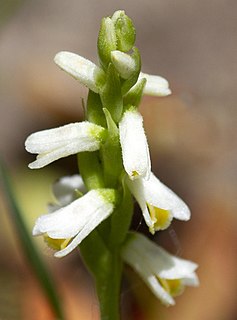
The grey partridge, also known as the English partridge, Hungarian partridge, or hun, is a gamebird in the pheasant family Phasianidae of the order Galliformes, gallinaceous birds. The scientific name is the Latin for "partridge", and is itself derived from Ancient Greek perdix.

The red-chested swallow is a small non-migratory passerine bird found in West Africa, the Congo Basin and Ethiopia. It has a long, deeply forked tail and curved, pointed wings.

Gymnanthes lucida, commonly known as shiny oysterwood or crabwood, is a species of flowering plant in the spurge family, Euphorbiaceae, that is native to southern Florida in the United States, the Bahamas, the Caribbean, Mexico, and Central America.

Salix lucida, the shining willow, Pacific willow, or whiplash willow, is a species of willow native to northern and western North America, occurring in wetland habitats.
Podocarpus hispaniolensis is a species of conifer in the family Podocarpaceae. It is endemic to the Dominican Republic.
Niceforonia lucida is a species of frog in the family Craugastoridae. It is endemic to Peru and known from the Cordillera Central west of the Apurímac River in the Ayacucho Region. Common name Cannatella's Andes frog has been coined for it. The specific name lucida refers to distinctive coloration of this frog relative to frogs in the genus Phrynopus, the genus where this species was initially placed. However, later studies have moved it to other genera where its colors are less distinctive.

The shining flycatcher is a species of bird in the family Monarchidae. It is found in northern Australia, and from the Moluccas to the Bismarck Archipelago. Its natural habitats are subtropical or tropical moist lowland forest and subtropical or tropical mangrove forest.

The ruddy treeshrew is a treeshrew species in the family Tupaiidae. It is endemic to Borneo, the Natuna Islands and the Anambas Islands.

Klarobelia is a genus of flowering plants in the family Annonaceae. There are about 12 species.

Klarobelia megalocarpa is a species of flowering plants in the family Annonaceae. It is endemic to Ecuador. Its natural habitat is subtropical or tropical moist lowland forests. It is threatened by habitat loss.
Parashorea lucida is a species of plant in the family Dipterocarpaceae. The name lucida is derived from Latin and refers to the venation on the leaf. It is a tall emergent tree, up to 60 m tall, found in mixed dipterocarp forest on clay and clay soils. It is found in Sumatra and Borneo. It is threatened by habitat loss.

Rawsonia lucida is a species of plant in the Achariaceae family. It is found in eastern, central and southern Africa.

The Santarém parakeet, also known as Hellmayr's parakeet or in aviculture as Hellmayr's conure or the Santarém conure, is a species of parrot in the family Psittacidae. It is found in the eastern and central sections of the Amazon basin south of the Amazon River, only just extending onto the northern bank of this river.

Cymothoe caenis, the common glider, is a species of butterfly of the family Nymphalidae. It is found in Guinea, Sierra Leone, Liberia, Ivory Coast, Ghana, Togo, southern Nigeria, Cameroon, the Republic of the Congo, the Central African Republic, Angola, the Democratic Republic of the Congo, Uganda, Tanzania and Zambia. The habitat consists of forests and heavy woodland. It is a migratory species.

The fiery copper or dull copper is an endemic Australian butterfly of the family Lycaenidae. One of the two subspecies, P. p. lucida, is commonly known as the Eltham copper.

Lyonia lucida is a species of flowering plant in the family Ericaceae known by the common names fetterbush lyonia, hurrahbush, and staggerbush. Other plants may also be called fetterbush. This broadleaved evergreen plant grows on the coastal plain of the southeastern United States from Virginia to Florida to Louisiana. It also occurs in Cuba.

Dinoponera lucida is a large queenless species of ant in the subfamily Ponerinae. The species, endemic to Brazil, is threatened by habitat destruction. Workers range from 27 to 30 mm in body length, which is slightly larger than the related species Dinoponera australis, but smaller than other large ants. Males are unknown.

Byrsonima lucida is a species of plant in the Malpighiaceae family. It is endemic to islands in the Caribbean and to the U.S. state of Florida. It is a shrub or small tree, and produces pink flowers. Its natural habitat is hammocks in dry limestone rocklands, and in sandy pine-palm woods.
Poeciliopsis lucida, the clearfin livebearer, is a species of small freshwater fish in the family Poeciliidae. Reproduction is viviparous, and the female can have several clutches of young developing internally at the same time. It is one of several species of small livebearing fish endemic to Mexico that were described in 1960 by the American ichthyologist Robert Rush Miller.

Spiranthes lucida, the shining ladies'-tresses, is a species of orchid native to northeastern North America.
















